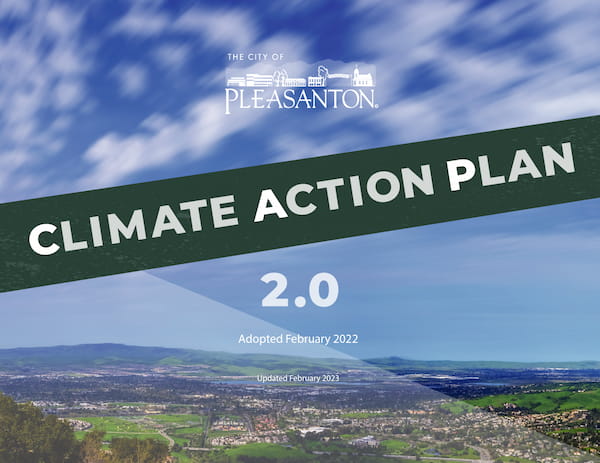Climate Action Plan
Project Description
The City of Pleasanton’s Council adopted an updated Climate Action Plan (CAP 2.0) in February 2022, with minor revisions in February 2023. CAP 2.0 updates the City’s original CAP, which was adopted in 2012. It outlines local actions to reduce greenhouse gas (GHG) emissions, enhance environmental sustainability and prepare for climate change.
The State of California considers GHG emissions and impacts of global warming to be a serious threat to the public health, environment, economic well-being and natural resources of California. While climate change is a global issue, actions taken at the local level can collectively have a meaningful impact on reducing GHG emissions. Since Pleasanton’s original CAP was adopted, a multitude of strategies to monitor and address climate change have emerged. Further, the State has adopted legislation establishing GHG emission reduction targets.
Assembly Bill 32, Executive Order B-55-18 and Executive Order S-3-05, have established statewide GHG emission reduction targets of 40-percent below 1990 emission levels by 2030, carbon neutrality by 2045 and GHG emission reduction targets of 80-percent below 1990 emission levels by 2050. CAP 2.0’s actions will allow the City to do its part to meet these targets.
CAP 2.0 Process and Outreach
The CAP 2.0 update process involved extensive public outreach including public meetings, workshops, surveys, videos and other tools to help the community engage. Materials from the process, including documents from public meetings that were held between 2019 and 2022 are available in the links below.

Current Project Status
City Council adopted the CAP 2.0 and the CAP is being implemented.
Virtual Engagement
The City is committed to protecting the health of its community. As such, due to COVID-19, the City is not holding in-person public meetings to discuss CAP 2.0 at this time. For updates on COVID-19 and the City’s response, please visit the City’s homepage. While in-person community outreach for the project is postponed until further notice, there will be virtual engagement opportunities including public hearings, workshops and online engagement.
To receive invitations to future community workshops and project updates throughout the CAP 2.0 process, sign-up below.
Throughout the Climate Action Plan update (CAP 2.0) process, there will be surveys, videos and other opportunities to learn more about the project and engage virtually.
Videos
- What should Pleasanton do to address Climate Change? Watch the Local Leaders of the 21st Century Club at Foothill High School Video here: Click here to watch the video on YouTube
- What do you want to protect in Pleasanton? Watch the Local Leaders of the 21st Century Club at Amador Valley High School Video here: Click here to watch the video on YouTube
- Watch the CAP 2.0 Intro Video: Click here to watch the video on YouTube
Resources
The City Council adopted the CAP 2.0 on February 15, 2022 and provided a minor update on February 21, 2023.
CAP 2.0 Public Hearings
Below are links to meeting materials (e.g., agenda reports and attachments) from public hearings related to the Climate Action Plan update.
- February 15, 2022 City Council- Meeting materials
- January 26, 2022 Energy and Environment Commission- Meeting materials
- December 21, 2021 City Council- Meeting materials
- December 15, 2021 Energy and Environment Commission- Meeting materials
- November 2, 2021 City Council- Meeting materials
- August 11, 2021 Energy and Environment Commission- Meeting materials
- April 21, 2021 Energy and Environment Commission- Meeting materials
- March 31, 2021 Youth Commission- Meeting materials
- March 24, 2021 Planning Commission- Meeting materials
- March 24, 2021 Energy and Environment Commission- Meeting materials
- March 22, 2021- Bicycle, Pedestrian and Trails Committee- Meeting Materials
- March 18, 2021- Economic Vitality Committee- Meeting Materials
- March 11, 2021 Parks and Recreation Commission- Meeting Materials
- February 3, 2021 Energy and Environment Commission- Meeting materials
- January 27, 2021 Energy and Environment Commission- Meeting materials
- December 9, 2020 Energy and Environment Commission- Meeting materials
- November 17, 2020 City Council- Meeting materials
- October 29, 2020 Energy and Environment Commission- Meeting materials
- October 7, 2020 Energy and Environment Commission- Meeting materials
- September 2, 2020 Energy and Environment Commission- Meeting materials
- August 5, 2020 Energy and Environment Commission- Meeting materials
- January 22, 2020 Energy and Environment Commission-Meeting materials
- December 17, 2019 City Council- Meeting materials
- November 18, 2019 Energy and Environment Commission- Meeting materials
- July 31, 2019 Energy and Environment Commission- Meeting materials
CAP 2.0 Documents
Below are documents related to the Climate Action Plan update.
- Final Draft CAP 2.0
- Final Draft CAP 2.0 Appendix A
- Final Draft CAP 2.0 Appendix B
- Final Draft CEQA IS-ND
- Adopted CAP 2.0 Summary
- Cost Benefit Analysis
- Outreach Meetings Summary
- Community Workshop Summary
- Online Survey #2 Results
- Draft Prioritized Strategies and Actions
- Online Survey #1 Results
- GHG Emission Inventory, Forecast and Target Reductions
- Vulnerability Assessment
- CAP 1.0 Progress
- Baseline Community Assessment
- Request For Proposals
Background Documents
Below are various background documents related to the Climate Action Plan update.
Greenhouse Gas Inventory
The city’s greenhouse gas (GHG) inventory quantifies the GHG emissions resulting from activities taking place throughout Pleasanton by the community. The 2005 inventory creates an emissions baseline against which the City can set emissions reduction targets and measure future progress. The 2017 inventory is the most recent inventory completed for the City. The inventories provide an understanding of where GHG emissions are originating and allows the city to develop effective policies, strategies and programs to reduce emissions.
2017 Inventory
The 2017 greenhouse gas (GHG) emissions inventory is the most recent inventory completed by the City. It serves as the inventory to inform development of future GHG emissions forecasts that will assist the City in setting GHG emissions targets that are consistent with State-level goals and the Pleasanton General Plan 2005-2025. Emissions were estimated to be 588,553 metric tons (MT) of carbon dioxide equivalent (CO2e). Figure 1 and Table 1 below display the inventory results by sector.
2005 and 2017 Comparison
The City’s first inventory in 2005 serves as the baseline inventory with the 2017 inventory serving as the current inventory. Between 2005 and 2017, Pleasanton experienced a population increase of 15 percent but had a total emissions reduction of 28 percent. Pleasanton reduced GHG emissions in every sector except for nonresidential gas (which may have increased due to growth in development of the commercial and industrial sectors within the City). Table 2 summarizes GHG emission changes and Table 3 summarizes changes in activity data.
Emissions Forecasts- Business-As-Usual
A business-as-usual (BAU) future GHG emissions forecast provides a forecast of how GHG emissions would change over time if consumption and activity trends were to continue as they did in 2017 and if growth were to occur as projected in the City’s 2005-2025 General Plan and Association of Bay Government’s future demographic forecasts. This does not include emission reductions from any regulations which would reduce local emissions. BAU forecast results for 2020, 2025, 2030, 2040, 2045 and 2050 are provided in Table 4.
Emissions Forecasts- Adjusted
California has enacted multiple regulations that will reduce future local emissions. The impact of these regulations on GHG emissions have been incorporated into an adjusted forecast, which provides a more accurate picture of future emissions growth and the emission reduction the City and community will be responsible for after State regulations have been implemented. These State regulations include but are not limited to SB 100 (which sets a goal for reaching 100 percent electricity from renewable energy and zero-carbon sources by 2045) and California Air Resources Board (CARB) tailpipe emissions standards (Pavley Standards, Advanced Clean Cars Program). Calculating the difference between the adjusted forecast and the reduction targets set by the City determines the gap to be closed through City CAP policy implementation. The adjusted forecast is shown below in Table 5 and Figure 2.
For more information on the GHG emission inventory, forecasts and target pathways, click here.
Administration Hours
Megan Campbell
Associate Planner, Community Development Department
Tel: (925) 931-5610
Mailing Address
Megan Campbell
Community Development Planning Division
PO. Box 520
Pleasanton, CA 94566
Contact us by filling out the form below:
